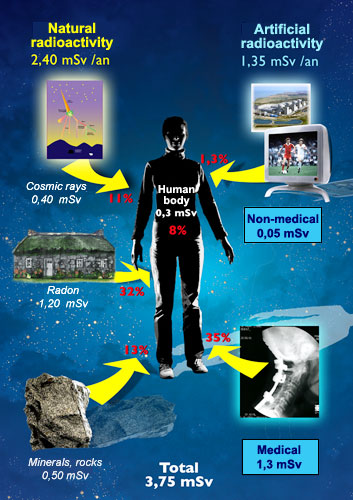Artificial radiation: the price for better healthcare
For about a century, humanity has been exposed to radiation sources other than those occurring naturally. These new sources are almost all for our benefit, with a large number of medical advances requiring higher levels of exposure. Even with all our new inventions, however, the primary source of exposure remains in average naturally-occurring radiation.
In large part, most of the ‘artificial’ rays in medicine are not the result of nuclear reactions. Instead, these are rays from the internal layers of the atom: known as X-rays. Despite their differing origins, X-rays and alpha/beta/gamma rays all have similar effects on living tissue. As a result, they are often grouped together when discussing protection from overexposure

Prevalance of medical exposures
The breakdown of the principal sources of radiations in developed countries shows the dominance of medical contributions in the non natural exposures . The non-medical contribution is principally due to X-rays emitted by television and computer screens, radiation emitted by smoke detectors and luminous dials, and nuclear after-effects (of atomic tests, nuclear reactors and, of course, disasters such as Chernobyl. In Western Europe, this last factor accounts for less than 1% of the total exposure.)
© Jean-Marc Faday (CNRS/Images-Média)
Discounting those individuals whose profession entails higher doses of radiation, virtually all artificial exposure encountered by humans originates from medical examinations. This dose is, on average, about 1.3 mSv in countries with at least one doctor per 1000 people – 30% of the total exposure rate. Countries such as Belgium, with an excellent health service, have doses as high as 1.95 mSv, whereas many Third World countries have doses lower than 0.040 mSv.
It must be remembered that this discussion revolves around averages. This is because, like with all such health risks, one’s age, fitness level, and way of life greatly influence the way one is affected.
It is difficult to reduce these medical doses in any way other than by improving the equipment involved. To renounce to X-rays, CT-scans, examinations of nuclear medicine examinations would mean givup up the benefits of modern medicine.
However, the use of ionizing radiations should be justified. If this happens, one will seek to use them most effectively. The doses would be limited according to the goal to achieve. In radiological protection, the principles of justification, optimization and justification are the rule for non natural sources of exposure.
Contribution of expositions outside medicine
Of the 1.3 mSv originating from non-natural sources, the non-medical contribution is estimated to be of 0.050 mSv. This dose comes from such diverse sources as computer screens, televisions, smoke detectors and illuminated dials. Contrary to the urban myths, nuclear power stations and the remnants from atomic bomb tests amount to less than 0.020 mSv – 1 or 2% of the total dose. This low figure is a result of the great precautions taken at the heart of nuclear reactors to isolate all radioactive material present. People living near nuclear reactors receive three times less radiation in spending a year at home than they would in one transatlantic flight.
The radioactive waste produced by nuclear plants is dealt with in such a way as to minimize all potential risk. The storage of such waste in protected sites guarantees virtually zero impact on the environment; at least as far as human time scales are concerned.
After World War II and during the Cold War, the superpowers tested and re-tested atom bombs and the greatly feared hydrogen (H) bombs. The tests that were conducted in the 50’s and early 60’s were largely overground; and responsible for substantial nuclear pollution. Later tests, however, were carried out underground, and have been far less damaging. In total, the exposure as a result of these tests amounted to about two years’ worth of natural radiation. The time that has elapsed, however, means that the doses released by the atomic tests have been reduced to a few millionths of a sievert.
Articles on the subject « Artificial Radioactivity »
Medical exposures
The main exposure from man-made radiation Apart from natural radioactivity, the main source of ra[...]
Nuclear Activities
Nuclear plants : Very low exposures under normal conditions In what seems a paradox, nuclear powe[...]
Radioactive Sources
Sealed sources and radioactive tracers: multiple applications Minute quantities of radioactive at[...]